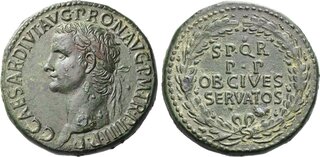| Numismatica Ars Classica > Auction 144 with CNG & NGSA | Auction date: 8 May 2024 |
| Lot number: 1023 Price realized: This lot is for sale in an upcoming auction - Bid on this lot  | Show similar lots on CoinArchives Find similar lots in upcoming auctions on |
| Lot description: The Geoffrey Cope Collection of Ancient Greek and Roman Bronzes. The Roman Empire. Gaius augustus, 37 – 41. Description Sestertius, Roma 40-41, Æ 34 mm, 29.98 g. C CAESAR DIVI AVG PRON AVG P M TR P IIII P P Laureate head l. Rev. S P Q R / P P / OB CIVES / SERVATOS within wreath. Reference C 26 BMC p. 157, note * RIC 53 CBN 116 Condition Rare. A magnificent portrait perfectly centred on a broad flan and a wonderful emerald-green patina. Extremely fine Provenance NAC sale 40, 2007, 658 NAC sale 54, 2010, 333 NAC sale 64, 2012, 1106 Note: : This impressive sestertius reflects the general importance that Caligula's coinage placed on his descent and on the imitation of Augustan themes as a means of advertising his legitimacy as emperor. The legend surrounding his magnificent portrait here makes a point of naming him as pro nepos (great grandson) of the Divus Augustus while the reverse depicting the corona civica casts Caligula's reign as following in the footsteps of Augustus. Under the Roman Republic, the oak wreath that made up the corona civica was traditionally awarded to a soldier who saved the life of a fellow citizen in battle. However, when Octavian assumed the title of Augustus and became the first Roman emperor in 27 BC, the Senate granted him this honour on the grounds that his rule had saved the people of Rome and of the entire empire from the cycle of civil war. When Tiberius died, probably with Caligula's help, the latter was recognized as the rightful heir to the imperial purple in AD 37. On the occasion of his accession, the Senate also presented Caligula with the corona civica for saving his fellow citizens. On the one hand, his assumption of power had prevented the return of civil war since Tiberius had died without a natural heir, but on the other, his replacement of Tiberius as emperor had saved Rome, and especially the senatorial class, from the treason trials and executions that had characterised the later years of Tiberius' reign. It is more than a little ironic that this wonderful piece was struck at the end of Caligula's reign, by which time his desire for unfettered rule placed him at odds with the Senate. The increasing acrimony in the relationship between emperor and Senate led Caligula to take every opportunity to denigrate the senatorial class, and even went so far as to propose a consulship with his favourite race horse. By 39, he had revived the Tiberian treason trials and was an imminent threat to the lives and livelihoods of many of the men who had hailed him as a saviour only two years before. The increasingly severe conflict with the senate was only brought to an end by Caligula's assassination in early 41. After his uncle Claudius was put forward by the Praetorian Guard as a replacement for Caligula, he too assumed the corona civica. Through its long and storied history Rome was frequently in need of saving from its saviours. Estimate: 7500 CHF |  |



